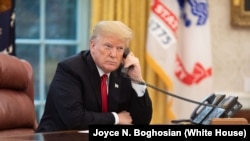President Donald Trump will enjoy the backdrop of a mostly solid economy as he delivers his second State of the Union address Tuesday night, though questions about its sustainability linger.
Trump will likely tout the latest signs of strength: Friday's jobs report showed that employers added the most jobs in January in nearly a year. The proportion of Americans working or looking for work reached a roughly five-year high. And a separate report showed that factory output rose at a healthy clip in December.
Those figures, however, haven't fully erased concerns about an array of headwinds facing the U.S. economy this year.
Several challenges loom: Overseas growth is stumbling, led by weakness in China, the world's second-largest economy. Europe is hamstrung by a recession in Italy and the potential for an unruly Brexit. A trade war between the U.S. and China and higher U.S. mortgage rates, partly engineered by the Federal Reserve, remain threats. The impact of the administration's tax cut may fade. And a 35-day partial government shutdown will likely trim official measures of growth for the first quarter, economists say.
U.S. businesses are defying those headwinds, for now. Many analysts attribute the economy's current health to Trump's tax cuts in late 2017 and a jump in government spending last year, as part of a budget deal between the administration and Congress.
"No other major economy in the world did what we did," said Ethan Harris, global economist at Bank of America Merrill Lynch. "The stimulus did a very good job of covering up all the blemishes of the economy, including the risks of the trade war."
Economic growth reached 3.8 percent last spring and summer, the fastest six-month pace in four years. It also accelerated job gains at a time when many economists expected hiring to slow. With the unemployment rate already low, analysts figured that companies would have fewer unemployed people to hire.
Yet employers stepped up their hiring and drove the unemployment rate down to 3.7 percent in November, the lowest in five decades. It has since ticked up to 4 percent, partly because of government workers who were temporarily unemployed because of the shutdown.
White House officials say the good times will continue. Kevin Hassett, a top administration economist, forecasts that growth will clock in at 3 percent a year for the next decade. He predicts that the administration's corporate tax cuts will entice businesses to invest more in machinery, software and buildings, which will make workers more productive and generate longer-term growth.
So far there is little evidence that that is happening, economists say. After a burst of investment in the first half of last year, companies have since pulled back on spending. Some economists attribute their caution to the administration's trade war with China.
"They're willing to add more people — that's good,'' said Diane Swonk, chief economist at Grant Thornton, referring to U.S. businesses. But "right now they're not willing to pull the trigger and bet on building more capacity. That undermines your foundation for future growth."
Most economists expect the impact of the tax cuts and extra government spending to fade as the year progresses and for the rate hikes the Fed has already imposed to hold back growth somewhat. Inevitably, too, a prolonged global slump would weaken the U.S. economy as well.
Harris forecasts that growth will slow to a 2 percent annual rate in the final three months of this year. Economists at JPMorgan Chase expect it will be just 1.5 percent.
Exactly how the U.S. economy is faring is harder than usual to judge because many data reports, including the quarterly figures on growth, are still delayed from the shutdown. The government hasn't yet said when it will release its first estimate of gross domestic product — the broadest gauge of the economy — for the final three months of 2018.
Trends that had looked alarming a month or two ago now appear benign, perhaps even supportive of growth. The stock market, having plunged nearly 20 percent late last year, rose 8 percent in January, its best monthly performance since 2015. Americans who are invested in stocks typically cut spending when market indexes fall steadily. That is now less likely to happen.
And suddenly the Fed under Chairman Jerome Powell looks like an economic ally. The central bank had raised its benchmark short-term interest rate four times last year — action that helped make mortgages and other consumer and business loans costlier. In December, the Fed's policymakers said they envisioned raising rates twice more this year.
But this week, the Fed held its benchmark rate steady and sent its strongest signal to date that it saw no need to raise rates in the coming months — perhaps even for the rest of the year. Its message ignited a rally on Wall Street, which cheered the prospect of continued modest borrowing rates for the near future.
At the same time, Swonk points out that home and auto sales are declining, suggesting they have peaked. A slowdown in such major purchases could weigh on growth in the coming months.










